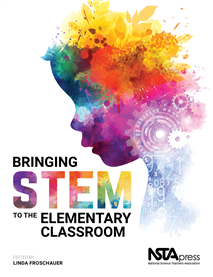All Book Chapters
Book Chapter
The lessons contained in this chapter highlight collaborating to improve teacher STEM preparation. This collaboration provided preservice teachers the unique opportunity to develop science units that could be implemented with young children at the lo...
Book Chapter
Am I Really Teaching Engineering to Elementary Students?
This chapter features lessons from an environmental engineering summer camp for first and second graders, with the goal of introducing students to engineering and to address the engineering design standards found in the Next Generation Science Standa...
Book Chapter
In this chapter, students investigate how to carry and transport a heavy object including designing and using a tool. With science, technology, engineering, and mathematical concepts involved, it could be included as part of a larger inquiry or proje...
Book Chapter
In this chapter, early childhood students design a piece of playground equipment using a 3-D printer. Kindergarten and first-grade students were charged with designing new playground equipment to create a solution to a problem of the school playgroun...
Book Chapter
In this chapter, second-grade students investigate material properties. Students were introduced to the Next Generation Science Standards model of the engineering design process (EDP) and given different materials to test to determine the best soluti...
Book Chapter
The true purpose of this activity is to introduce students to a five-step EDP (engineering design process). In this chapter, second graders design, build, test, and improve tools to map a waterway, and the design activities are described in detail as...
Book Chapter
Think It, Design It, Build It, Test It, Refine It
In this chapter, a unit on water quality ends with a water filtration engineering design activity and was a win-win situation. Students were already very curious to learn about water filtration after their study of water properties and water quality ...
Book Chapter
A design task helps students identify and find solutions to a school-yard problem. A module was conducted in four 90-minute sessions. Session 1, Preview module and introduce engineering with a warm-up design; Session 2, Unpack and explore the communi...
Book Chapter
This chapter shows how science and engineering practices can be integrated into the elementary classroom by providing snapshots of activities from a STEM curriculum unit. The unit, focused on aerospace engineering, challenges students to design parac...
Book Chapter
Designing a Sound-Reducing Wall
In this chapter, students explore engineering with a fun challenge. To help students better understand sound in a fun and engaging way, an engineering design–based science learning activity was conducted that is appropriate for a third- or fourth-g...
Book Chapter
Blade Structure and Wind Turbine Function
In this chapter, third and fifth graders co-investigate and co-design wind turbine blades and voltage output. The wind turbine lessons featured emerged from the desire to help students build on their learning about energy transformation. The goals of...
Book Chapter
You and Your Students as Green Engineers
In this chapter, using creativity and everyday materials to design and improve a solar oven highlights one teacher’s journey with her fifth-grade students as they embarked on an engineering adventure together. In this case, literacy, social studies...
Book Chapter
In this chapter, third-grade students solve a real-world problem using the engineering design process, collaborative group work, and integrated STEM education. By introducing students to the ideas of recycling and composting and by showing them the e...
Book Chapter
This chapter explores how one teacher employed 3-D printing technology with fourth-grade students in a STEAM (science, technology, engineering, arts, and mathematics) lab to design and create a prosthetic hand. This project-based unit provided a memo...
Book Chapter
In this chapter, a paper airplane investigation highlights scientific and engineering practices. The investigation relates to students’ personal experiences and interests and cultivates enthusiasm by allowing students to develop ideas about forces...


